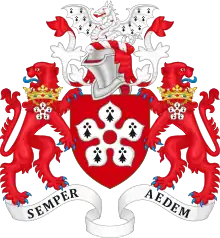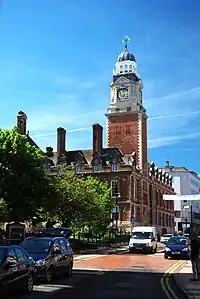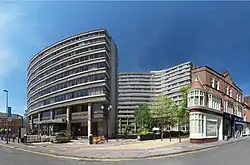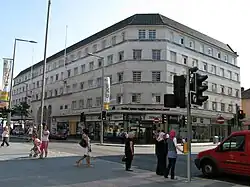Leicester City Council
Leicester City Council is a unitary authority responsible for local government in the city of Leicester, England. It consists of 54 councillors, representing 22 wards in the city, overseen by a directly elected mayor. It is currently controlled by the Labour Party and has been led by Mayor Sir Peter Soulsby since his election on 6 May 2011. The main council offices are at City Hall on Charles Street, but council meetings are held in the 19th-century Town Hall.[2]
Leicester City Council | |
|---|---|
 Coat of arms | |
 Council logo | |
| Type | |
| Type | |
| Leadership | |
George Cole since 19 May 2022 | |
Chief operating officer | Alison Greenhill |
| Structure | |
| Seats | 1 executive mayor 54 councillors[1] |
 | |
Council political groups |
|
Length of term | Executive mayor elected every four years Whole council elected every four years |
| Elections | |
Council voting system | Plurality-at-large |
Mayor voting system | First-past-the-post voting |
Last Council election | 4 May 2023 |
Next Council election | May 2027 |
| Meeting place | |
 | |
| Leicester Town Hall | |
| Website | |
| www | |


As a unitary authority, the council is responsible for running nearly all local services in Leicester with the exception of the Leicestershire Fire and Rescue Service and Leicestershire Constabulary which are run by joint boards with Leicestershire County Council and Rutland County Council.
History
The Council traces its roots to the Corporation of Leicester, and before then to the Merchant Gild and the Portmanmoot. The Portmanmoot consisted of 24 Jurats, elected from the burgesses (members of the Gild Merchant, or freemen), along with two bailiffs, and a clerk. It appears to have existed before the Norman Conquest in 1066. In 1209, the lead member of the Portmanmoot, the Alderman, became known as a mayor. The Gild Merchant and the Moot overlapped in membership and had probably become effectively merged in the 14th century. Membership of the Twenty-Four appears to have been by co-option, chosen by themselves.
Traditionally, the general populace attended some meetings of the Moot and Guild, but this was restricted to burgesses in 1467. Later, in 1489, this changed to a system where the Mayor and the Twenty-Four chose Forty-Eight burgesses to represent the others, and the Twenty-Four and the Forty-Eight would govern jointly.
After doubts as to the ability of the Moot and Gild to hold property arose in the 16th century, the Corporation was formed, replacing the Gild and Portmanmoot, in 1589. A second charter was granted in 1599, reconfirming this, to The Mayor, Bailiffs and Burgesses of the Borough of Leicester. The 24 Jurats became known as the Aldermen of the Corporation, and the 48 other Burgesses as the Common Council. The members of the Corporation chose the burgesses to send to the House of Commons.
The Corporation, as with most English municipal corporations, continued effectively unreformed until the Municipal Reform Act of 1835, although the freemen in general obtained the right to participate in the election of MPs after the Restoration. The Municipal Reform Act replaced the existing system of co-option for members of the council with elections by rate-payers. This led to a prolonged spell of Liberal control of the council.
Leicester became, in 1889, under the Local Government Act, a county borough. The Corporation was replaced in 1974 under the Local Government Act 1972, with the modern Leicester City Council, a non-metropolitan district council under Leicestershire County Council. Leicestershire County Council's jurisdiction over the City of Leicester was transferred to the City Council on 1 April 1997, making it a unitary authority, as part of the 1990s UK local government reform.
Lord Mayor
The position of Lord Mayor of Leicester is mainly a ceremonial post, and is combined with that of chairman of the council. The position is elected yearly by members of the council and rotates.
Wards
The City is divided into 21 electoral wards, each of which returns two or three councillors, using the bloc voting system, as follows:[3]
| Ward | Councillors | Notes |
|---|---|---|
| Abbey | 3 | from Abbey Park up to Stocking Farm and Mowmacre Hill |
| Aylestone | 2 | Aylestone Village, Gilmorton estate, part of Aylestone Park, Aylestone Meadows, one side of Saffron Lane from the Porkpie roundabout to Knighton Lane and Aylestone Road/Lutterworth Road from Grace Road to the county border at Glen Parva. |
| Beaumont Leys | 3 | |
| Belgrave | 3 | most of the Belgrave area |
| Braunstone Park & Rowley Fields | 3 | including most of Braunstone |
| Castle | 3 | city centre, Southfields, Clarendon Park |
| Evington | 3 | |
| Eyres Monsell | 2 | |
| Fosse | 2 | |
| Humberstone & Hamilton | 3 | including Nether Hall |
| Knighton | 3 | |
| North Evington | 3 | |
| Rushey Mead | 3 | Includes parts of the Belgrave area including Agar Street. |
| Saffron | 2 | |
| Spinney Hills | 2 | including parts of Highfields |
| Stoneygate | 3 | also including parts of Highfields |
| Thurncourt | 2 | The Thurnby Lodge estate |
| Troon | 2 | The Northfields estate, parts of the former Charnwood ward and a small part of the Rushey Mead area |
| Westcotes | 2 | |
| Western | 3 | The New Parks estate |
| Wycliffe | 2 | St Matthew's estate and part of Highfields |
A new set of wards and ward boundaries came into effect for the 7 May 2015 council elections. Wards that previously existed and were abolished are Charnwood, Coleman, Freeman, Latimer, New Parks and Western Park.
The previous ward boundaries were adopted for the 2003 local elections.[4] Prior to this, there had been 28 wards, each electing 2 members. Wards that had existed and been abolished were Crown Hills, East Knighton, Mowmacre, North Braunstone, Rowley Fields, Saffron, St Augustine's, West Humberstone, West Knighton and Wycliffe.
Political control
The current composition of the council is as follows:
| Party | 2023 Election | Current Composition | |
|---|---|---|---|
| Labour | 31 | 30 | |
| Conservative | 17 | 17 | |
| Liberal Democrats | 3 | 3 | |
| Green | 3 | 3 | |
| Independent | 0 | 1[5] | |
In December 2010 the council voted to introduce a directly elected mayor with effect from May 2011. Sir Peter Soulsby was elected to the post with 55% of the vote on the first ballot. He was re-elected in May 2015, 2019 and 2023 to serve four-year terms.
The next election is due to take place in May 2027,[6] although by-elections take place when a seat becomes vacant due to resignation or death of a councillor.
Arms
 |
|
Notes
References
- "Open Council Data UK - compositions councillors parties wards elections".
- "Annual Meeting, Council, The Council Chamber, First Floor, Town Hall, Town Hall Square, Leicester". 18 May 2023. Retrieved 1 October 2023.
- Local Government Boundary Commission for England. "Leicester (Electoral Changes) Order 2014". www.lgbce.org.uk. Archived from the original on 18 April 2015. Retrieved 30 March 2015.
- Local Government Boundary Commission for England. "Electoral review of Leicester 2002". www.lgbce.org.uk. Archived from the original on 18 April 2015. Retrieved 30 March 2015.
- Patel, Asha; Moorhouse, Sam (31 August 2023). "Councillor quits party after whole Labour branch suspended". LeicestershireLive. Retrieved 1 September 2023.
- Keith Adkins. "UK Local Government Information - Trailor 2019". uklocalgov. Retrieved 25 January 2017.
- "East Midlands Region". Civic Heraldry of England. Retrieved 5 March 2021.
